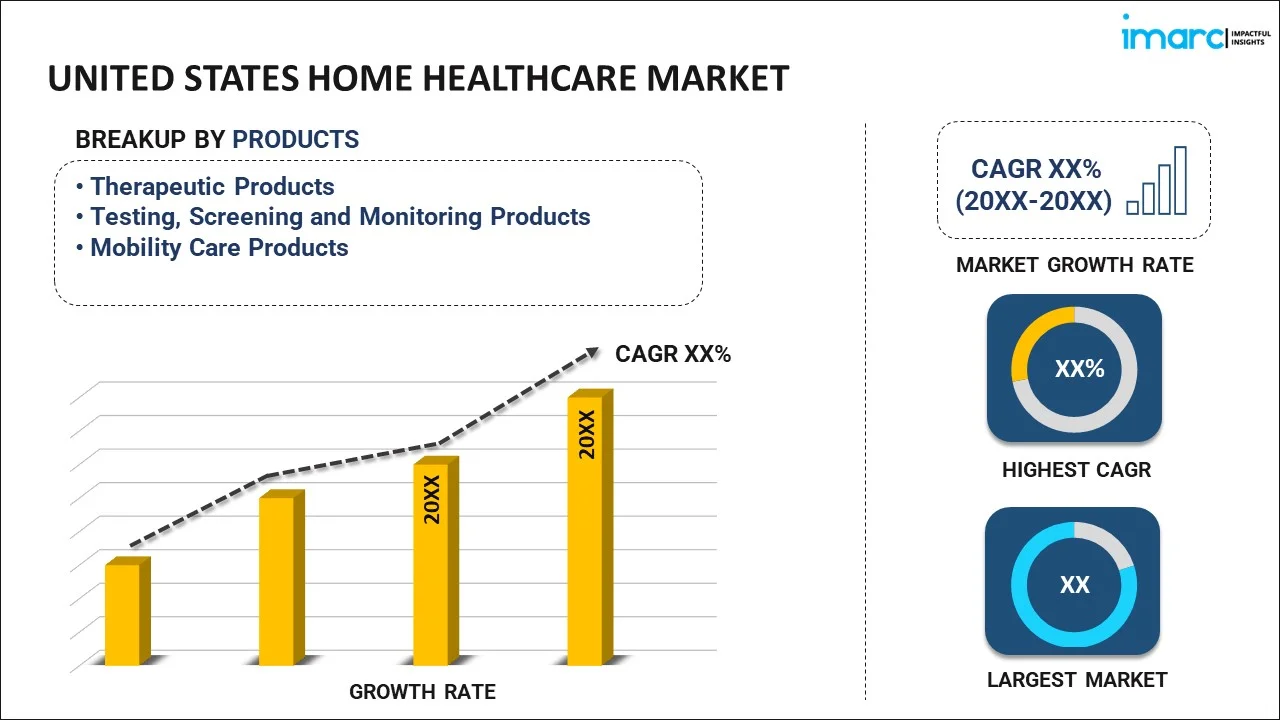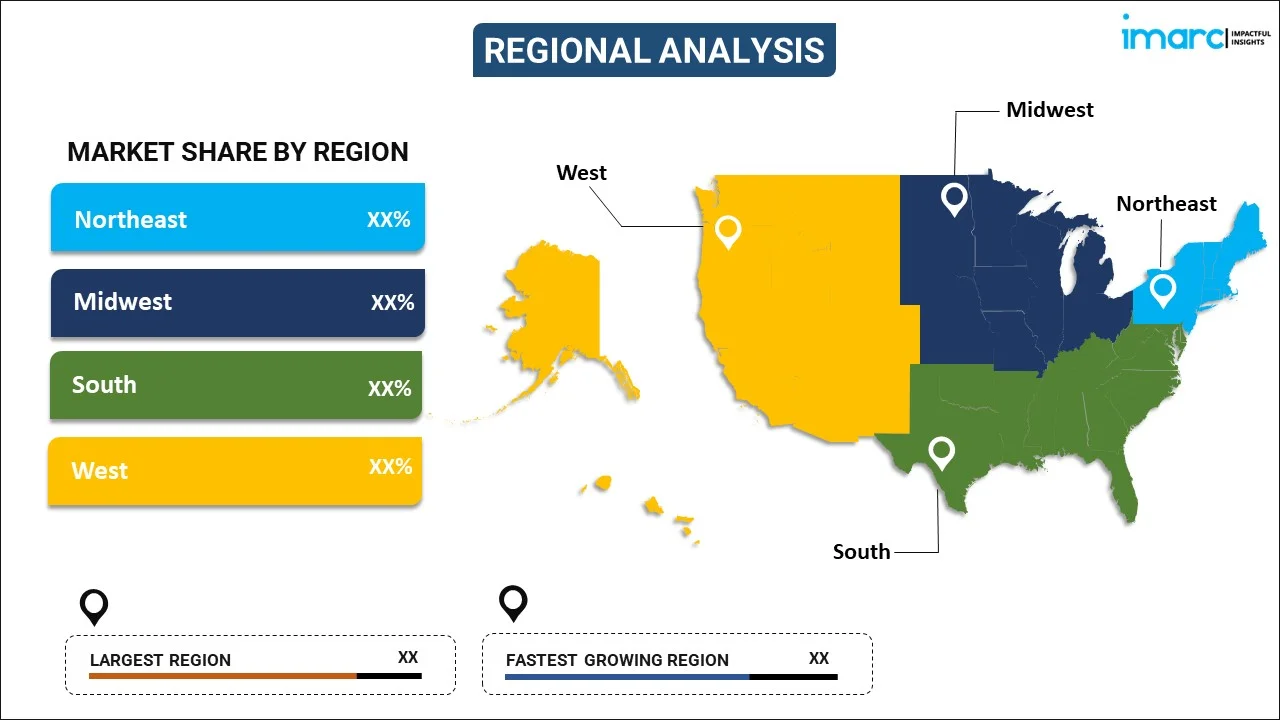
United States Home Healthcare Market Report by Product (Therapeutic Products, Testing, Screening and Monitoring Products, Mobility Care Products), Service (Skilled Nursing, Rehabilitation Therapy, Hospice and Palliative Care, Unskilled Care, Respiratory Therapy, Infusion Therapy, Pregnancy Care), Indication (Cancer, Respiratory Diseases, Movement Disorders, Cardiovascular Diseases and Hypertension, Pregnancy, Wound Care, Diabetes, Hearing Disorders, and Others), and Region 2025-2033
Market Overview:
The United States home healthcare market size reached USD 96.8 Billion in 2024. Looking forward, IMARC Group expects the market to reach USD 179.5 Billion by 2033, exhibiting a growth rate (CAGR) of 7.1% during 2025-2033. The increasing geriatric population, which has created a substantial need for healthcare solutions, the rising prevalence of chronic diseases resulting in the demand for continuous monitoring and continual technological advancements in telemedicine, remote patient monitoring, and digital healthcare platforms represent some of the key factors driving the market.
|
Report Attribute
|
Key Statistics
|
|---|---|
|
Base Year
|
2024 |
|
Forecast Years
|
2025-2033
|
|
Historical Years
|
2019-2024
|
| Market Size in 2024 | USD 96.8 Billion |
| Market Forecast in 2033 | USD 179.5 Billion |
| Market Growth Rate (2025-2033) | 7.1% |
United States Home Healthcare Market Analysis:
- Major Market Drivers: Rising geriatric population, growing incidence of chronic diseases, and affordability of cost-effective treatment at home are significant drivers. Advances in remote care and support from insurance companies also drive the United States home healthcare market growth.
- Key Market Trends: Telehealth service expansion, individual care plans, and the incorporation of AI-based monitoring devices are the defining trends. The move by the industry toward value-based care and prevention models puts focus on the forthcoming market trends in patient engagement and delivery of care.
- Competitive Landscape: The market is segmented with many providers providing specialized and multidisciplinary services. Firms are investing in mobile platforms, workforce training, and remote diagnostics to make offerings differentiated so that they can be scaled up while achieving more market share through service innovation.
- Challenges and Opportunities: Workforce gaps and reimbursement issues are challenges on an ongoing basis. But there are opportunities in broadening rural access, improving interoperability, and using AI-powered analytics. These technologies have the potential to unlock new possibilities for analysis of the market and long-term care viability.
Home healthcare refers to a broad spectrum of medical and non-medical services delivered at a patient's residence, designed to treat, manage, and prevent various health conditions. These services encompass skilled nursing care, physical therapy, occupational therapy, speech therapy, and other support services such as meal preparation and medication management. The system aims to provide a comfortable and personalized healthcare experience, emphasizing individual needs and preferences. Working in collaboration with primary care physicians, the home healthcare team develops and implements a customized care plan that may include monitoring vital signs, wound care, injections, health assessments, and patient and caregiver education. Utilizing modern technologies and equipment, these professionals ensure accurate treatment and timely intervention if needed. The benefits of home healthcare include comfort and privacy, more efficient use of healthcare resources, potential cost savings, and the encouragement of patient responsibility and empowerment. Additionally, the approach aligns with the contemporary emphasis on patient-centered care, preventive measures, and integrated healthcare, reflecting a holistic perspective on well-being and quality of life.
United States Home Healthcare Market Trends:
Scaling Up Remote Patient Monitoring (RPM) Technologies
Remote Patient Monitoring (RPM) is emerging as a building block of contemporary home healthcare provision in the United States. As digital infrastructure improves and the demand for real-time data grows, patients and providers increasingly rely on connected health devices to monitor vital signs and chronic conditions. This includes wearable sensors, Bluetooth-enabled devices, and mobile health applications that transmit patient data directly to healthcare providers. The convergence of RPM technologies is intended to enhance proactive care and lessen the necessity for repeated in-person visits, particularly for elderly populations who have diabetes, hypertension, and cardiovascular disease. The trend is highlighted to reflect the change toward preventive and data-centric approaches of care. United States home healthcare market analysis states that this innovation greatly favors the scalability and efficiency of the sector. The implementation of RPM is also expected to play a major part in the market expansion because payers and providers have aligned incentives with better patient outcomes and fewer hospital readmissions.
Increase of Personalized and Condition-Specific Care Plans
The provision of personalized care solutions is increasingly becoming prominent in the U.S. home healthcare sector. Providers are adapting services according to patient demographics, medical history, and cultural background, thus providing targeted care for chronic diseases, post-surgery rehabilitation, and end-of-life care. Advanced assessment tools now enable professionals to develop dynamic care plans that change with respect to clinical improvement and patient input. This process boosts satisfaction, promotes treatment compliance, and enables improved clinical outcomes. As healthcare systems decentralize further, patient-specific, subtle models are anticipated to increase in demand across the market. Focusing on United States home healthcare market trends, such a shift towards personalization is transforming service standards and expectations alike. The development contributes to a larger market share, especially for health systems and private agencies that seek to differentiate themselves through value-based, outcome-oriented care. This direction is indicative of the industry's strategic focus on long-term involvement and quality enhancement through accurate service provision.
Multidisciplinary In-Home Service Integration
A comprehensive model of care is increasingly being adopted in U.S. home healthcare, typified by the integration of multidisciplinary services such as physical therapy, nursing, nutrition counseling, mental health services, and social work. This coordinated strategy meets complex and multifactorial patient needs, especially among those with multiple chronic conditions or post-acute needs. Utilizing interoperable platforms and collaborative workflows, providers can guarantee end-to-end service delivery that aligns with physical as well as emotional well-being. This model has been found to be advantageous in curbing emergency care utilization and enhancing quality-adjusted life years (QALYs). Emphasizing United States home healthcare market share, this cross-disciplinary trend is driving the industry's consistent market growth through enhanced care continuity and patient retention. As reiterated in recent analysis of the market, players are investing in joint service models to maximize health outcomes while ensuring cost-effectiveness across various patient populations in urban and rural environments.
United States Home Healthcare Market Segmentation:
IMARC Group provides an analysis of the key trends in each segment of the United States home healthcare market report, along with forecasts at the country level for 2025-2033. Our report has categorized the market based on product, service and indication.
Product Insights:

To get more information on this market, Request Sample
- Therapeutic Products
- Testing, Screening and Monitoring Products
- Mobility Care Products
The report has provided a detailed breakup and analysis of the market based on the product. This includes therapeutic products, testing, screening and monitoring products, and mobility care products.
Service Insights:
- Skilled Nursing
- Rehabilitation Therapy
- Hospice and Palliative Care
- Unskilled Care
- Respiratory Therapy
- Infusion Therapy
- Pregnancy Care
The report has provided a detailed breakup and analysis of the market based on the service. This includes skilled nursing, rehabilitation therapy, hospice and palliative care, unskilled care, respiratory therapy, infusion therapy, and pregnancy care.
Indication Insights:
- Cancer
- Respiratory Diseases
- Movement Disorders
- Cardiovascular Diseases and Hypertension
- Pregnancy
- Wound Care
- Diabetes
- Hearing Disorders
- Others
A detailed breakup and analysis of the market based on the indication has also been provided in the report. This includes cancer, respiratory diseases, movement disorders, cardiovascular diseases and hypertension, pregnancy, wound care, diabetes, hearing disorders, and others.
Regional Insights:

- Northeast
- Midwest
- South
- West
The report has also provided a comprehensive analysis of all the major regional markets, which include Northeast, Midwest, South, West.
Competitive Landscape:
The report has also provided a comprehensive analysis of the competitive landscape in the market. Competitive analysis such as market structure, key player positioning, top winning strategies, competitive dashboard, and company evaluation quadrant has been covered in the report. Also, detailed profiles of all major companies have been provided.
Latest News and Developments:
- In May 2025, Axle Health shifted to a SaaS model and secured $10 million in Series A funding to scale its AI-driven logistics platform. The solution assists home healthcare providers by automating clinician scheduling, routing, and workflows, solving operational inefficiencies in the expanding U.S. home-based care market.
- In April 2025, the U.S. Congress extended the Hospital-at-Home waiver to September, allowing sustained hospital-level care at home. The model minimizes readmissions, enhances outcomes, and reduces costs. The American Hospital Association advocates further extension to secure long-term stability and increase Medicaid engagement in acute care at home.
United States Home Healthcare Market Report Coverage:
| Report Features | Details |
|---|---|
| Base Year of the Analysis | 2024 |
| Historical Period | 2019-2024 |
| Forecast Period | 2025-2033 |
| Units | Billion USD |
| Scope of the Report | Exploration of Historical and Forecast Trends, Industry Catalysts and Challenges, Segment-Wise Historical and Predictive Market Assessment:
|
| Products Covered | Therapeutic Products, Testing, Screening and Monitoring Products, Mobility Care Products |
| Services Covered | Skilled Nursing, Rehabilitation Therapy, Hospice and Palliative Care, Unskilled Care, Respiratory Therapy, Infusion Therapy, Pregnancy Care |
| Indications Covered | Cancer, Respiratory Diseases, Movement Disorders, Cardiovascular Diseases and Hypertension, Pregnancy, Wound Care, Diabetes, Hearing Disorders, Others |
| Regions Covered | Northeast, Midwest, South, West |
| Customization Scope | 10% Free Customization |
| Post-Sale Analyst Support | 10-12 Weeks |
| Delivery Format | PDF and Excel through Email (We can also provide the editable version of the report in PPT/Word format on special request) |
Key Benefits for Stakeholders:
- IMARC’s report offers a comprehensive quantitative analysis of various market segments, historical and current market trends, market forecasts, and dynamics of the United States home healthcare market from 2019-2033.
- The research study provides the latest information on the market drivers, challenges, and opportunities in the United States home healthcare market.
- Porter's five forces analysis assist stakeholders in assessing the impact of new entrants, competitive rivalry, supplier power, buyer power, and the threat of substitution. It helps stakeholders to analyze the level of competition within the United States home healthcare industry and its attractiveness.
- Competitive landscape allows stakeholders to understand their competitive environment and provides an insight into the current positions of key players in the market.
Key Questions Answered in This Report
The home healthcare market in the United States was valued at USD 96.8 Billion in 2024.
The United States home healthcare market is projected to exhibit a CAGR of 7.1% during 2025-2033, reaching a value of USD 179.5 Billion by 2033.
Major drivers of the market are a geriatric population, growth in the incidence of chronic diseases, improvements in remote monitoring and telehealth technology, and a trend towards cost-saving, in-home care options. There are also favorable government initiatives and increasing patient desire for patient-centred care contributing greatly to United States home healthcare market growth.
Need more help?
- Speak to our experienced analysts for insights on the current market scenarios.
- Include additional segments and countries to customize the report as per your requirement.
- Gain an unparalleled competitive advantage in your domain by understanding how to utilize the report and positively impacting your operations and revenue.
- For further assistance, please connect with our analysts.
 Inquire Before Buying
Inquire Before Buying
 Speak to an Analyst
Speak to an Analyst
 Request Brochure
Request Brochure
 Request Customization
Request Customization




.webp)




.webp)












